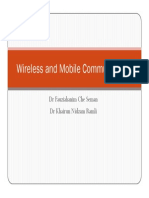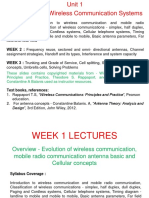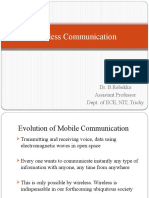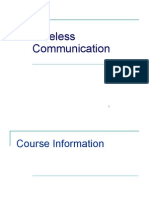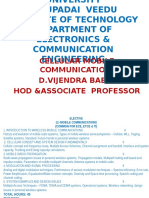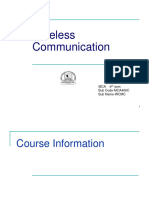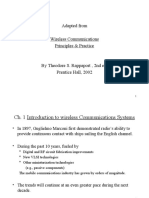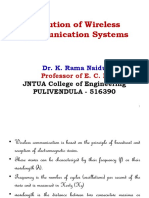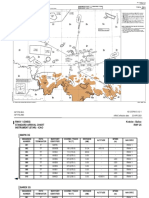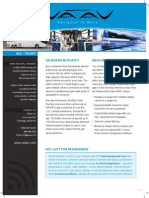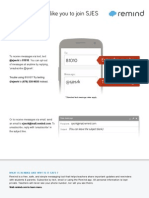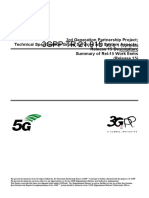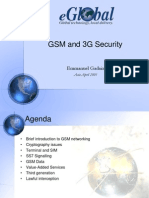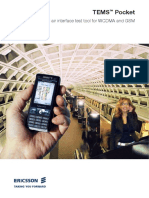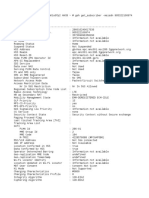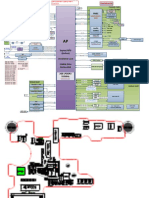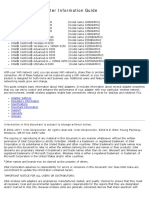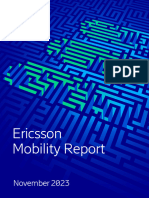ECE 8708 Wireless Communications : Introduction to Wireless Communication Systems
Chapters 1-2
Introduction to
Wireless Communication Systems
Yimin Zhang, Ph.D.
Department of Electrical & Computer Engineering
Villanova University
http://yiminzhang.com/ECE8708
Yimin Zhang, Villanova University
�ECE 8708 Wireless Communications : Introduction to Wireless Communication Systems
Outlines
History
Examples of Mobile Radio Systems
Cordless Phone / Paging System / Cellular System
Cellular Process
To a mobile user / From a mobile user
Roaming
2G, 2.5G, 3G Technologies
Frequency Spectrum Allocations
Yimin Zhang, Villanova University
�ECE 8708 Wireless Communications : Introduction to Wireless Communication Systems
A little History and Evolution of Mobile Radio
1897:
Marconi invented wireless concept
1960s & 1970s:
Bell laboratories developed the cellular concept
1970s:
Development of highly reliable, miniature solid state radio
frequency hardware
Wireless communication era was born
Yimin Zhang, Villanova University
�ECE 8708 Wireless Communications : Introduction to Wireless Communication Systems
Wireless Communications
Cellular phone users
1984
- 25,000
1994
- 16 million
1997
- 50 million
2000
- Number of wireless users = Number of wired users
Yimin Zhang, Villanova University
�ECE 8708 Wireless Communications : Introduction to Wireless Communication Systems
Worldwide Cellular Telephone Subscribers
Yimin Zhang, Villanova University
�ECE 8708 Wireless Communications : Introduction to Wireless Communication Systems
The first portable units were really big and heavy.
Yimin Zhang, Villanova University
�ECE 8708 Wireless Communications : Introduction to Wireless Communication Systems
Cellular Technologies
Analog Cellular Technologies
AMPS
Advanced Mobile Phone System. Developed by Bell Labs in the 1970s and
first used commercially in the United States in 1983. It operates in the 800
and 1900 MHz band in the United States and is the most widely distributed
analog cellular standard.
Digital Cellular Technologies
D-AMPS
(IS-54,
now
rolled into
IS-136)
Digital AMPS. Designed to use existing channels more efficiently, D-AMPS
(IS-136) employs the same 30 kHz channel spacing and frequency bands
(824-849 and 869-894 MHz) as AMPS. By using TDMA instead of
frequency division multiple access or FDMA, IS-136 increases the number
of users from 1 to 3 per channel. An AMPS/D-AMPS infrastructure can
support either Analog AMPS phone or digital AMPS phones. (The Federal
Communications Commission mandated that digital cellular in the U.S.
must act in a dual-mode capacity with analog). Operates in the 800 MHz
band and 1900 MHz.
Yimin Zhang, Villanova University
�ECE 8708 Wireless Communications : Introduction to Wireless Communication Systems
Cellular Technologies
Digital Cellular Technologies
GSM
Global System for Mobile Communications. The first European digital
standard, developed to establish cellular compatibility throughout Europe.
Its success has spread to all parts of the world and over 80 GSM networks
are now operational. It operates at 900 and 1800 MHz in many parts of
Europe and in England. Works at 1900 MHz in some parts of the United
States. TDMA based.
PCS
Personal Communications Service. The PCS frequency band in America is
1850 to 1990 MHz, encompassing a wide range of new digital cellular
standards like N-CDMA and GSM 1900. Single-band GSM 900 phones
cannot be used on PCS networks. PCS networks operate throughout the
USA.
Yimin Zhang, Villanova University
�ECE 8708 Wireless Communications : Introduction to Wireless Communication Systems
Cellular Technologies
Digital Cellular Technologies
CDMA
Code Division Multiple Access. Developed by Qualcomm characterized by
high capacity and small cell radius. It uses the same frequency bands as
AMPS and supports AMPS operation, employing spread-spectrum
technology and a special coding scheme. It was adopted by the
Telecommunications Industry Association (TIA) in 1993.
cdmaOne Wide ranging wireless specification involving IS 95, IS-96, IS-98, IS-99, IS634 and IS-41.AT&T, Motorola, Lucent, ALPS, GSIC, Prime Co,
Qualcomm, Samsung, Sony, US West, Sprint, Bell Atlantic, Time
Warner are sponsors.
Yimin Zhang, Villanova University
�ECE 8708 Wireless Communications : Introduction to Wireless Communication Systems
North America Goes to Digital: IS-54
In 1990 North American carriers faced the question -- how do we increase
capacity? -- do we pick an analog or digital method? The answer was digital. In
March 1990 the North American cellular network incorporated the IS-54B
standard, the first North American dual mode digital cellular standard. This
standard won over Motorola's Narrowband AMPS or NAMPS, an analog scheme
that increased capacity by cutting down voice channels from 30KHz to 10KHz. IS54 on the other hand increased capacity by digital means: sampling, digitizing,
and then multiplexing conversations, a technique called TDMA. This method
separates calls by time, placing parts of individual conversations on the same
frequency, one after the next. It tripled call capacity.
Using IS-54, a cellular carrier could convert any of its systems' analog voice
channels to digital. A dual mode phone uses digital channels where available and
defaults to regular AMPS where they are not. IS-54 was, in fact, backward
compatible with analog cellular and indeed happily co-exists on the same radio
channels as AMPS. No analog customers were left behind; they simply couldn't
access IS-54's new features. CANTEL got IS-54 going in Canada in 1992. IS-54
also supported authentication, a help in preventing fraud. IS-54, now rolled into
IS-136, accounts for perhaps half of the cellular radio accounts in this country.
Yimin Zhang, Villanova University
10
�ECE 8708 Wireless Communications : Introduction to Wireless Communication Systems
The Rise of GSM
Europeans saw things differently. No new telephone system could
accommodate their existing services on so many frequencies. They
decided instead to start a new technology in a new radio band. Cellular
structured but fully digital, the new service would incorporate the best
thinking of the time. They patterned their new wireless standard after
landline requirements for ISDN, hoping to make a wireless counterpart
to it. The new service was called GSM.
GSM first stood for Groupe Speciale Mobile, after the study group that
created the standard. It's now known as Global System for Mobile
Communications, although the "C" isn't included in the abbreviation.
Yimin Zhang, Villanova University
11
�ECE 8708 Wireless Communications : Introduction to Wireless Communication Systems
Key Specifications of 2G Technologies
Yimin Zhang, Villanova University
12
�ECE 8708 Wireless Communications : Introduction to Wireless Communication Systems
Upgrade Paths
Yimin Zhang, Villanova University
13
�ECE 8708 Wireless Communications : Introduction to Wireless Communication Systems
2.5G and 3G Data Communication Standards
Yimin Zhang, Villanova University
14
�ECE 8708 Wireless Communications : Introduction to Wireless Communication Systems
Examples of Mobile Radio Systems
Garage door openers
Remote controllers for home entertainment
Cordless telephones
Hand-held walkie-talkies
Pagers/beepers
Cellular telephones
Yimin Zhang, Villanova University
15
�ECE 8708 Wireless Communications : Introduction to Wireless Communication Systems
Mobile Communication Systems - Mobile Station
Required
Coverage
infraService
range
structure
Complexity
Hardware Carrier Functioncost
frequency
ality
TV
remote
control
low
low
low
low
infra-red
transmitter
Garage
door
opener
low
low
low
low
<100
MHz
transmitter
Paging
system
high
high
low
low
<1 GHz
receiver
Cordless
phone
low
low
moderate
low
<100
MHz
transceiver
Cellular
phone
high
high
high
moderate <1 GHz
Yimin Zhang, Villanova University
transceiver
16
�ECE 8708 Wireless Communications : Introduction to Wireless Communication Systems
Mobile Communication Systems - Base Station
Required
infraService Coverage
range
structure
Complexity
Hardware Carrier Functioncost
frequency
ality
TV
remote
control
low
low
low
low
infra-red
receiver
Garage
door
opener
low
low
low
low
<100
MHz
receiver
Paging
system
high
high
high
high
<1 GHz
transmitter
Cordless
phone
low
low
low
moderate
<100
MHz
transceiver
Cellular
phone
high
high
high
high
<1 GHz
transceiver
Yimin Zhang, Villanova University
17
�ECE 8708 Wireless Communications : Introduction to Wireless Communication Systems
... Examples of Mobile Radio Systems
Mobile Describes a radio terminal attached to a high speed
mobile platform (e.g., A cellular phone in a fast moving vehicle).
Portable Describes a radio terminal that can be hand-held and
used by someone at walking speed (e.g., cordless telephone).
Subscriber Mobile or portable user.
Base stations Link mobiles through a backbone network.
Yimin Zhang, Villanova University
18
�ECE 8708 Wireless Communications : Introduction to Wireless Communication Systems
Types of Mobile Radio Transmission Systems
Simplex Communication is possible only in one direction,
(e.g., paging systems).
Half Duplex Two way communication, but uses the same
radio channel for both transmission and reception.
User can only transmit or receive information.
Full Duplex Simultaneous two-way radio transmission and
reception between subscriber and base station.
Two simultaneous but separate channels (FDD) or
Adjacent timeslots on a single radio channel (TDD)
Yimin Zhang, Villanova University
19
�ECE 8708 Wireless Communications : Introduction to Wireless Communication Systems
Cordless Telephone Systems
Full duplex communication
Few hundred meters
Public
Switched
Telephone
Network
(PSTN)
Fixed
Port
(Base
Station)
Yimin Zhang, Villanova University
wireless
link
cordless
handset
20
�ECE 8708 Wireless Communications : Introduction to Wireless Communication Systems
Paging Systems
Paging systems are communication systems that send brief
messages to a subscriber...
Numeric messages
Alpha-numeric message
Voice message
News headlines
Stock quotes
Faxes
Paging System Coverage Areas
2 to 5 km
Within individual buildings
Worldwide coverage
Yimin Zhang, Villanova University
21
�ECE 8708 Wireless Communications : Introduction to Wireless Communication Systems
Paging System: Wide Area System
The paging control center dispatches pages received from the Public
Switched Telephone Network (PSTN) throughout several cities at
the same time.
PSTN
Landline link
City 1:
Paging
terminal
Landline link
City 2:
Paging
terminal
Paging
control
center
Satellite link
City N:
Paging
terminal
Yimin Zhang, Villanova University
22
�ECE 8708 Wireless Communications : Introduction to Wireless Communication Systems
Cellular System
Base stations
(towers) provide radio
access between
mobile users and
Mobile Switching
Center (MSC).
Mobile Switching
Center
PSTN
Yimin Zhang, Villanova University
23
�ECE 8708 Wireless Communications : Introduction to Wireless Communication Systems
Base Station - Mobile Network
RVC
RCC
FVC
FCC
Forward Voice Channel
Reverse Voice Channel
Forward Control Channel
Reverse Control Channel
Yimin Zhang, Villanova University
24
�ECE 8708 Wireless Communications : Introduction to Wireless Communication Systems
Functions of Cellular System
Provides wireless connection to the PSTN for any user location
within the radio range of the system.
High capacity is achieved:
by limiting the coverage of each base station transmitter to a small
geographical area called a Cell, and
by the same radio channels being reused by another base station
located some distance away Frequency reuse.
Switching system, called handoff, enables call to proceed
uninterrupted when the user moves from one cell to another.
Typical MSC handles 100,000 cellular
simultaneous conversations at a time.
Yimin Zhang, Villanova University
users
and
5,000
25
�ECE 8708 Wireless Communications : Introduction to Wireless Communication Systems
Telephone Call Made To Mobile User
Incoming
Incoming
Telephone
Telephone
Call
Call to
to
Mobile
Mobile X
X
PSTN
PSTN
Step
Step 11
Mobile
Switching
Center
Base
Base Stations
Stations
2,
2, 66
55
44
3,
3, 77
Mobile
Mobile X
X
Yimin Zhang, Villanova University
26
�ECE 8708 Wireless Communications : Introduction to Wireless Communication Systems
Brief Outline of Cellular Process:
Telephone Call Placed to a Mobile User
Yimin Zhang, Villanova University
27
�ECE 8708 Wireless Communications : Introduction to Wireless Communication Systems
Brief Outline of Cellular Process:
Telephone Call Placed to a Mobile User
Step 1 The incoming telephone call to Mobile X is received at the
MSC.
Step 2 The MSC dispatches the request to all base stations in the
cellular system.
Step 3 The base stations broadcast the Mobile Identification Number
(MIN), telephone number of Mobile X, as a paging message over the
FCC throughout the cellular system.
Step 4 The mobile receives the paging message sent by the base
station it monitors and responds by identifying itself over the reverse
control channel.
Step 5 The base station relays the acknowledgement sent by the
mobile and informs the MSC of the handshake.
Step 6 The MSC instructs the base station to move the call to an
issued voice channel within in the cell.
Yimin Zhang, Villanova University
28
�ECE 8708 Wireless Communications : Introduction to Wireless Communication Systems
Brief Outline of Cellular Process:
Telephone Call Placed to a Mobile User
Step 7 The base station signals the mobile to change frequencies to
an unused forward and reverse voice channel pair.
At the point another data message (alert) is transmitted over the
forward voice channel to instruct the mobile to ring.
Now the call is in progress. The MSC adjusts the transmitted power of
the mobile and changes the channel of the mobile end and base
stations in order to maintain call quality.
Yimin Zhang, Villanova University
29
�ECE 8708 Wireless Communications : Introduction to Wireless Communication Systems
Telephone Call Placed by Mobile
Mobile
Switching
Center
33
22
PSTN
PSTN
11
Yimin Zhang, Villanova University
Telephone
Telephone
Call
Call Placed
Placed
by
by Mobile
Mobile X
X
30
�ECE 8708 Wireless Communications : Introduction to Wireless Communication Systems
Telephone Call Placed by Mobile
Yimin Zhang, Villanova University
31
�ECE 8708 Wireless Communications : Introduction to Wireless Communication Systems
Telephone Call Placed by Mobile
Step 1 When a mobile originates a call, it sends the base station its
telephone number (MIN), electronic serial number (ESN), and
telephone number of called party. It also transmits a station class
mark (SCM) which indicates what the maximum power level is for
the particular user.
Step 2 The cell base station receives the data and sends it to the
MSC.
Step 3 The MSC validates the request, makes connection to the
called party through the PSTN and validates the base station and
mobile user to move to an unused forward and reverse channel pair
to allow the conversation to begin.
Yimin Zhang, Villanova University
32
�ECE 8708 Wireless Communications : Introduction to Wireless Communication Systems
Roaming
All cellular systems provide a service called roaming.
This allows subscribers to operate in service areas other than
the one from which service is subscribed.
When a mobile enters a city or geographic area that is different
from its home service area, it is registered as a roamer in the
new service area.
Periodically, the MSC issues a global command over each
FCC in the system, asking for all mobiles which are previously
unregistered to report their MIN and ESN over the RCC for
billing purposes.
If a particular mobile user has roaming authorization for billing
purposes, MSC registers the subscriber as a valid roamer.
Yimin Zhang, Villanova University
33
�ECE 8708 Wireless Communications : Introduction to Wireless Communication Systems
Frequency Spectrum for US Cellular Radio Service
Channel
Number
Center Frequency
(MHZ)
1 N 799
.03 N + 825
991 N 1023
.03 (N 1023) + 825
1 N 799
.03 N + 870
991 N 1023
.03 (N 1023) + 870
Channels 800-990 are unused.
Yimin Zhang, Villanova University
34
�ECE 8708 Wireless Communications : Introduction to Wireless Communication Systems
Yimin Zhang, Villanova University
35
�ECE 8708 Wireless Communications : Introduction to Wireless Communication Systems
Outlines
History
Examples of Mobile Radio Systems
Cordless Phone / Paging System / Cellular System
Cellular Process
To a mobile user / From a mobile user
Roaming
2G, 2.5G, 3G Technologies
Frequency Spectrum Allocations
Yimin Zhang, Villanova University
36


